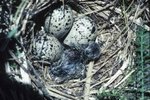
Inside a shelled egg is the second-best place to begin life; only being inside a living body provides a safer haven for the unborn. It's a closed, complete environment; everything the fetus needs is there. Birds and fish and reptiles lay eggs, among other animals. The eggs of the crocodile, a reptile who grows to 15 feet, are about the size of large chicken eggs but shaped differently and weighing more.
So Small
An egg of the American crocodile, a medium-size species that gets to be about 15 feet long when fully grown, is about the size of a large chicken egg or a small duck egg: some 3 inches long and 2 inches across. It's oval in shape and evenly rounded, instead of being slightly tapered at one end like a bird egg. It weighs about 3 ounces, slightly heavier than the average duck egg or large chicken egg.
In the White Room
When it's first laid, a crocodile egg is almost clear. The shell gradually becomes creamy white and opaque, but at the same time a chalky white spot develops exactly over the tiny embryo inside. This spot expands around the center of the egg as the embryo grows. Three-quarters of the way through the 80-day incubation period, the band is complete; by hatching day, the whole egg is chalk-white.
Touching
The surface of the American crocodile's egg is smooth, unlike the rougher egg of the American alligator, and hard, unlike the leather-shelled eggs of turtles and some snakes. Although you can't see them, the crocodile egg shell has microscopic openings or pores that allow the baby crocs to receive water and oxygen.
Incubation Station
In a tropical climate, any largish flattened area in sand, dirt or rotting weeds near water could be a crocodile nest. If it is, mama croc's likely nearby. Her clutch is buried here, keeping warm, and she guards it against marauders until the offspring are ready to hatch. She waits to hear the soft grunts of the babies as they break through the shells -- they're her signal to open the nest. If an egg hasn't hatched, she picks it up and rolls it gently in her mouth until it cracks. As babies emerge, she takes them in her mouth and carry them to the water, where they hide, and feast on bugs and minnows. Then mama's on her own again until next nesting season.
References
- Cabrillo College: Amniotic Eggs Allow Fully Terrestrial Life
- Smithsonian Institution: National Zoo: Cracking the Egg
- New Holland: Insights Into Crocodile Lifestyles
- 101 Sweet Pastry: Duck Eggs vs. Chicken Eggs in Baking
- South Florida Research Center: Report T-671 The Nest Environment of the American Crocodile (Crocodylus Acutus)
Resources
Photo Credits
-
Eduard Lysenko/iStock/Getty Images



